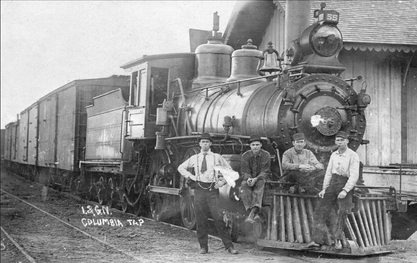
International and Great Northern Railroad
Houston Tap Railroad
Columbia Tap Railroad
Brazoria Tap Railroad
The International and Great Northern Railroad [I & GN RR] ran from Houston to Fresno, Arcola, Hawdon, Juliff and on to Angleton. Brazoria Tap RR, Columboa Tap RR and Houston Tap RR followed this route but were discontinued before the I & GN RR.
The road beside the I & G N RR was State HWY 19. [Later known as State HWY 288 and now FM 521]

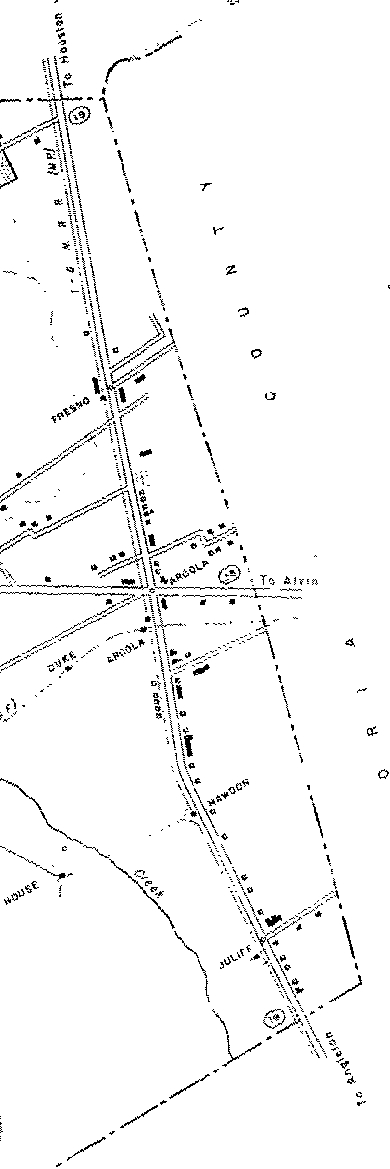
|
1856 |
HT |
The
Houston Tap Railway is begun with the goal to prevent all rail traffic from
bypassing Houston going directly to Harrisburg on the BBB&C. |
|
1856 |
HT&B |
The
Houston Tap and Brazoria Railway Company was chartered on September 1, 1856,
to run from Houston to Columbia in Brazoria County. The HT&B takes over
the HT. |
|
1860 |
HT&B |
The
HT&B reaches East Columbia after passing through east Fort Bend County.
Already has been tagged with the nickname "The Sugar Road", due to
its service to the many sugar plantations in Brazoria County. |
|
1866 |
H&GN |
Houston
and Great Northern was chartered. |
|
1869 |
HT&B |
On
February 6, 1869, it was bought at a sheriff's sale. |
|
1873 |
HT&B |
Houston
Tap and Brazoria was merged into the Houston and Great Northern. |
|
1873 |
I&GN |
The
International and Great Northern Railroad was formed by the consolidation of
the International Railroad Company and the Houston and Great Northern
Railroad |
|
1879 |
I&GN |
Reaches
Galveston through part ownership of the GH&H. |
|
1924 |
I&GN |
The
MP buys the I&GN through the New Orleans, Texas and Mexico Railway
Company (NOTM) |
|
1956 |
SL
/ I&GN / NOTM / MP |
The
SL, I&GN and NOTM are consolidated with the re-organized Missouri Pacific
Railroad Company and lose all unique identity. |
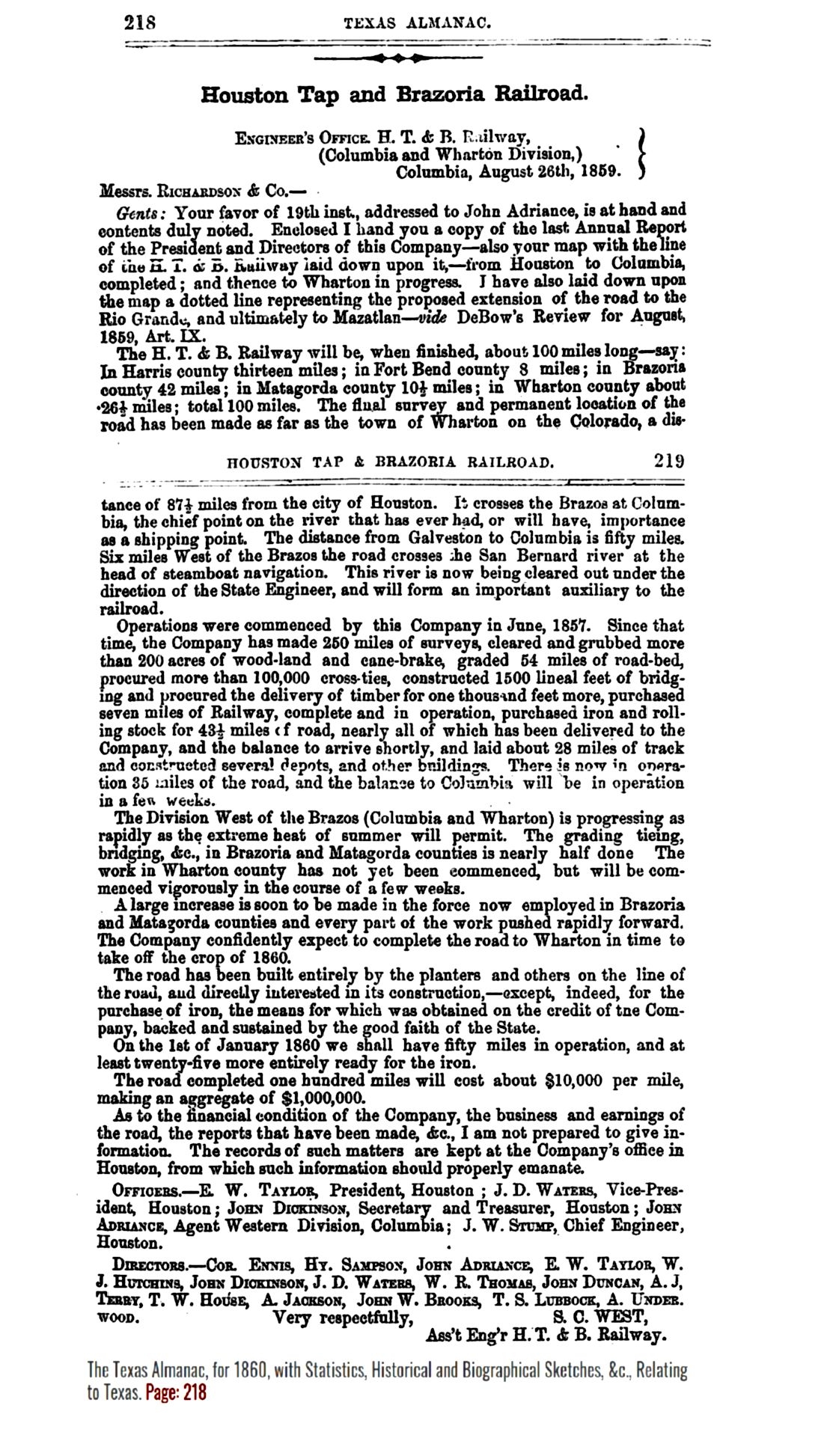
This railroad never crossed the Brazos River to Columbia. The Civil War broke out in 1860 and drained the men and resources. East Columbia and West Columbia have never had a railroad built to the towns.
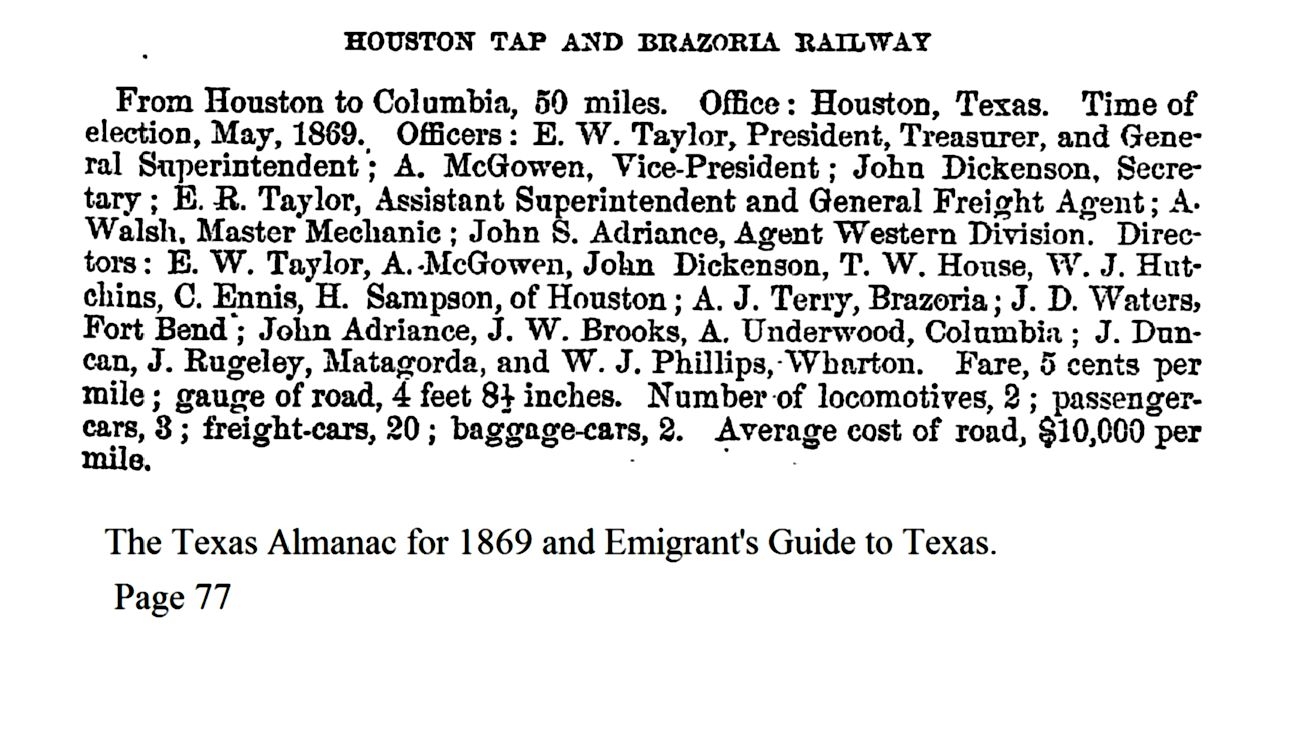
The Houston Belt and Terminal Railway Company was chartered on August 31, 1905, to provide passenger and freight terminals in Houston for four railroads. Three of the lines, the Trinity and Brazos Valley Railway Company, the Beaumont, Sour Lake and Western Railway Company, and the St. Louis, Brownsville and Mexico Railway Company, were part of the system being constructed by Benjamin F. Yoakum. The fourth participant was the Gulf, Colorado and Santa Fe Railway Company. Each railroad owned a 25 percent interest in the Houston Belt and Terminal. The office was in Houston and the initial capital was $25,000. Members of the first board of directors were Sam Lazarus, H. N. Tinker, Hyman Levy, J. M. Rockwell, Edward H. Harrell, B. F. Bonner, and John Summerfield. Construction began in 1905, and the Houston Belt and Terminal opened for operations on January 1, 1908. Construction of Union Depot began in 1909. Designed by the New York firm of Warren and Wetmore, the three-story station opened on March 1, 1911. Within two years an additional two stories were added. In order to build the passenger terminal, twelve blocks of land had to be cleared of some of the finest homes in the city. In mid-1916 the company operated twenty-three miles of main track and sixty-one miles of all tracks and owned seven locomotives and two cars. The Missouri, Kansas and Texas Railway Company of Texas was a tenant at Union Station for several years around 1912. During World War I the United States Railroad Administration took control of the railroads and moved the passenger trains of the International and Great Northern to the depot. This arrangement was formalized in 1921, and the International and Great Northern and its successor remained as tenants as long as the carrier existed. The last passenger train left Union Station on July 31, 1974. However, the station building remains in use for railroad offices, and the Houston Belt and Terminal continues to provide freight facilities for the Missouri Pacific Railroad Company, the Atchison, Topeka and Santa Fe Railway Company, and the Burlington Northern Railroad Company.
George C. Werner
OYSTER CREEK, TEXAS. Oyster creek (Oyster Creek Station, Oyster Creek) was a station on the Columbia Tap Railroad two miles south of Anchor in northeast Brazoria County. A post office was established as Oyster Creek in 1852, was discontinued in 1854, and reopened in 1871; it was renamed Oystercreek in 1894 and operated until 1899. In 1884 Oyster Creek shipped cotton and had a post office, a general store, several cotton gins, three steam sugar mills, and a population of 150. Thirty residents remained in 1890, and in 1896 the local school had nine pupils and one teacher. By 1914, however, the town no longer appeared in state gazetteers, and population estimates were unavailable.
MASTERSON, THOMAS G. (ca. 1813–1884). Thomas G. Masterson, attorney, businessman, and Brazoria County official, was born around 1813. He came to Texas in 1832 from Tennessee, where he had graduated from Nashville Law School, and bought land on the Brazos River near Velasco. He returned to Tennessee and married Christianie I. Roane in 1834. In 1838 the family moved to Texas and settled at Velasco, where Masterson dealt in real estate and was a partner of Edwin Waller in a mercantile business. Masterson held five separate mail contracts from March 1844 to April 1845, totalling 608 miles. By 1859 he had accumulated real estate valued at $9,000 and personal property valued at $3,500; other members of his household included Nancy Roane, aged sixty, born in Virginia, and Laura Masterson, aged thirty. In 1862 Masterson added 243 acres from the J. B. Cowan estate to his homestead. His second son, T. W., operated a sugar and cotton plantation on the property, which lay on the west bank of the Brazos River about a mile below Brazoria. Masterson owned another plantation, for which Masterson Station on the Columbia Tap Railroad was named, but did not live on it. This plantation was located west of the site of present Rosharon. Today the land is part of Ramsey Prison Farm .
PRISON SYSTEM). Masterson served as county clerk and chief justice of Brazoria County and was enrolling officer of the district during the Civil War. According to one source, he was a personal friend of Sam Houston. He was the father of six sons and two daughters. Masterson was a Mason. He died on the family plantation near Brazoria in 1884.
CHINA GROVE, TEXAS (Brazoria County). China Grove is twelve miles north of Angleton, two miles south of Rosharon, and west of State Highway 288 in northwest Brazoria County. It was named for the chinaberry trees planted for shade by Warren D. C. Hall, owner of the original land grant. Hall, who also raised figs and oranges, operated a plantation called China Grove for a time, then sold it in 1843 to Albert Sidney Johnston and Albert T. Burnley. Johnston took over his partner's interest, operated the plantation until 1849, and sold it in 1852. The China Grove station on the Columbia Tap Railroad, across the tracks from the plantation, served the area from at least as early as 1877 to 1892, when the town of Custer was established. In 1896 a black school in China Grove had eighty-seven pupils, and in 1906 two local black schools had 108 pupils and two teachers; that year a local white school had seven pupils and one teacher. In 1947 China Grove was a common school district with both white and black schools, but by 1974 only a single building and scattered dwellings remained. Of the original plantation, only hedges of Cherokee roses, thought to have been planted by Johnston, remained in 1991.
ROSHARON, TEXAS. Rosharon is at the intersection of Farm roads 521 and 1462, fourteen miles north of Angleton and 7½ miles east of the Brazos River in northern Brazoria County. The site was settled before the Civil War by cotton and sugar planters and probably had no name until 1859, when the Columbia Tap Railroad was completed and a stop there was named Masterson's Station for the owner of a nearby plantation. It was also known locally as Buttermilk Station because an early resident frequently brought a bucket of buttermilk and a dipper to the stop to treat the crew to a drink. About 1900 George Wetmore Colles bought property near the site. He called his place, and later the town, the Rose of Sharon Garden Ranch because of the Cherokee roses growing in the area. The town's name was later shortened to Rosharon. Colles obtained a post office in 1912 and designed the community water system. A. G. Arcaro operated the first store and the post office in one room of his house. After the business was sold, the post office was closed, then reopened in Boyd's Store thanks to the efforts of Tom Lochridge. This post office closed in 1920. Lochridge platted the townsite and had a cotton gin moved to Rosharon from Houston, thus providing employment for several persons. The gin's engine was used for the town's first power plant. He also operated the community's first telephone exchange in his home. The first school was held in a private home and later moved to a separate building. Some years later the Rosharon district was consolidated with the Angleton schools; students were bused to Angleton in the late twentieth century. Church meetings were first held in a former school, then in a tavern that community members had bought and converted into a church. Eventually a brick church was constructed. South Texas Water Company located in Rosharon in 1935, and its fresh watercanals for irrigating rice brought some seventy-five to eighty rice farmers to the area. The population was estimated at 500 in 1988, when the town had a post office. Most residents commuted to jobs in nearby towns, but the surrounding land was still used for ranching and farming. The main crops were rice and soybeans, with lesser amounts of corn and some cotton. Four units of the Texas Department of Corrections, three at Ramsey and one at Darrington, were located nearby, and TDC employees and their families added considerably to the town's economy (see PRISON SYSTEM). In 1990 and again in 2000 the population was 435.
HALL, WARREN D. C. (1794–1867). Warren D. C. Hall, early settler, was born in Union County, South Carolina, in 1794, the son of Warren and Mary Sims Hall. As a youth, he moved with his family to Louisiana. He studied law in Natchitoches and in 1812 joined the Mexican Republican Army of the North, under José Bernardo Gutiérrez de Lara and Augustus W. Magee. He was elected a captain in the Gutiérrez-Magee expedition and participated in the opening engagements, including the battle of Rosillo in 1813. He resigned his command and returned to Louisiana in protest against the butchery of royalist prisoners, reportedly ordered by Gutiérrez, at Alazán Heights. In November 1814, Hall volunteered to serve six months with a company of Louisiana volunteers and participated in the defense of New Orleans against the British as the War of 1812 ended. He received a bounty land warrant for 160 acres for his service.
In 1816–1817 Hall participated in filibustering expeditions, including one led by Francisco Xavier Mina and Gen. Louis Michel Aury that occupied Galveston Island. He also supported the revolutionary movement headed by Gen. James Long in 1819–1820. Though he allegedly befriended Jean Laffite on Galveston Island, Hall took no part in the buccaneer’s sometimes questionable activities.
In November 1828 Hall and his wife, Julietta, a native of New York, settled near Columbia in Brazoria County. After taking an oath of allegiance to the Mexican government on December 21, 1829, Hall quickly became active in colonial affairs. In 1832 he was second in command of the Texans at Anahuac in the protest against John Davis Bradburn and participated in the battle of Velasco. In October he attended the Convention of 1832 at San Felipe as a delegate from Liberty Municipality. Affairs were for a time quiet, and Hall retired to his farm. He was among the charter members of the first Masonic lodge in Texas, organized at Brazoria by John A. Wharton in 1834, and helped train William T. Austin for a duel with Wharton that year.
In 1835 Hall was made a member of the committee of safety at Columbia, and in November represented Columbia at the Consultation. After the revolution broke out he was able to advance Stephen F. Austin $500 in an 1835 campaign for "expresses, spies, corn, beeves, etc." Hall was appointed adjutant general by David G. Burnet early in 1836 and later acted as secretary of war of the Republic of Texas while Thomas J. Rusk was with the army. Hall held the rank of colonel and commanded the post at Velasco until May 26, after independence had been won at San Jacinto. He again served the republic in September 1842, when he joined the forces that expelled Adrián Woll.
After 1836 Hall practiced law in Brazoria County for several years and served three years (1843–46) as justice of the peace. He established China Grove Plantation, fourteen miles south of Houston, and raised sugar. Tax rolls for 1840 showed that he owned more than 17,000 acres of land and ninety slaves. In 1843, however, financial difficulties, which plagued him throughout his years in Texas, forced him to sell China Grove to Albert Sidney Johnston. He continued to reside in Brazoria County during the early 1850s when he surveyed and speculated in choice bottomland in Harris County and helped finance the building of the Columbus Tap Railroad.
By January 1853, Hall moved to west Galveston Island where is resided at a home called “Three Trees” and maintained a ferry to Velasco. He died of a stroke in Galveston in April 1867 and was buried in the Trinity Episcopal Cemetery there. His wife Juliette lived in Galveston until her death in March 1878. Hall County, which was created in 1876 and organized in 1890, was named in honor of Warren D. C. Hall.
The International-Great Northern Railroad Company was a major component of the Missouri Pacific lines in Texas. The railroad was formed on September 30, 1873, by the consolidation of the International Railroad Company and the Houston and Great Northern Railroad. The Houston and Great Northern was chartered on October 22, 1866, by the first legislature to meet after the Civil War, and was backed by eastern and local capital. At the time of the merger, the Houston and Great Northern owned 252 miles of track between Houston and Palestine, between Houston and East Columbia with branches from Phelps to Huntsville, and between Troup and Mineola. The mileage of the Houston and Great Northern included the former Houston Tap and Brazoria Railroad and the Huntsville Branch Railway, which had been merged on May 8, 1873. The International was chartered on August 5, 1870, and at the time of the consolidation operated 177 miles from Hearne to Longview. Despite the financial panic of 1873, the consolidated company continued to slowly expand, reaching Rockdale in 1874 and Austin on December 28, 1876. Building resumed in 1880, and the following year the railroad reached San Antonio and Laredo on December 1, 1881. On August 5, 1879, the International and Great Northern acquired the Georgetown Railroad Company at foreclosure and merged the latter company on June 2, 1882. The Henderson and Overton Branch Railroad Company was acquired on September 27, 1880. Although operated as a part of the International and Great Northern, the Henderson and Overton Branch was not consolidated until August 31, 1911. The various predecessor companies of the International and Great Northern earned 6,432,000 acres of state land. This land was sold for a net of $4,668,850 or about seventy-two cents an acre. The charter of the International called for the State of Texas to grant $10,000 in bonds to the company for each mile completed. However, when the company applied for the bonds Comptroller Albert A. Bledsoe refused to sign and register the bonds. A compromise was worked out whereby the railroad was granted twenty sections of land per mile constructed rather than the normal sixteen sections. In addition, the railroad was exempted from state taxation for twenty-five years. The International and Great Northern entered receivership on April 1, 1878, was sold at foreclosure, and conveyed to a new company organized under the original charter on November 1, 1879. The second receivership lasted from February 21, 1889, to July 11, 1892, but the company was reorganized financially without sale or change of name. At the time of the reorganization, the railroad owned eighty-eight locomotives, sixty-one passenger cars, 1,919 freight cars, and eighty company service cars. Earnings that year included $1,076,695 in passenger revenue and $2,530,451 in freight revenue.
Jay Gould acquired control of the International and Great Northern in December 1880. The company was leased to the Missouri, Kansas and Texas Railway Company, another Gould company, for ninety-nine years on June 1, 1881, but the lease was canceled on March 2, 1888, and the railroad was again operated by its own organization. The company owned 756 miles of track at the end of 1882 and did not increase mileage until after 1900. On May 1, 1901, the International and Great Northern merged the Calvert, Waco and Brazos Valley Railroad Company. The latter company had built sixty-six miles of a line between Spring, just north of Houston, and Fort Worth. The Fort Worth line was completed in 1902 by the International and Great Northern. The following year a forty-five-mile branch was built between Navasota and Madisonville. In that year the railroad also acquired the Houston, Oaklawn and Magnolia Park Railway Company. The company again entered receivership on February 27, 1908. A new company, the International and Great Northern Railway Company, was chartered on August 10, 1911, and bought the old company at foreclosure on August 31, 1911. At this time the Henderson and Overton Branch was also consolidated, giving the International and Great Northern its peak of 1,106 miles. In addition, the International and Great Northern owned the Austin Dam and Suburban Railway Company and a 50 percent interest in the Galveston, Houston and Henderson Railroad Company. Less than three years later the reorganized company was forced into receivership, which lasted until the railroad was sold at foreclosure on July 28, 1922. A new company, the International-Great Northern Railroad Company, was chartered on August 17, 1922.
The Missouri Pacific Railroad Company, the Texas and Pacific Railway Company, and the International and Great Northern had worked together as a system through Gould holdings in each company rather than by any direct control by the Missouri Pacific. By the early 1920s, however, the Gould interests no longer controlled the railroads, and in 1922 the St. Louis-San Francisco Railway Company attempted to acquire the International-Great Northern. Although the Interstate Commerce Commission refused to authorize the purchase, the threat of losing a major Texas connection led to the Missouri Pacific's acquisition of the International-Great Northern. It did this through the New Orleans, Texas and Mexico Railway Company, which bought the International-Great Northern on June 20, 1924. When the New Orleans, Texas and Mexico was itself acquired by the Missouri Pacific on January 1, 1925, the International-Great Northern became part of the Missouri Pacific Lines, although the company continued to be operated separately. Major components of the Missouri Pacific Lines, including the International-Great Northern, entered receivership on March 31, 1933. This receivership was to last for twenty-three years, primarily due to the inability of the various financial interests involved to agree on a reorganization plan. A plan was finally adopted, and on March 1, 1956, the International-Great Northern was merged into the reorganized Missouri Pacific Railroad Company. During the receivership the International-Great Northern abandoned two branch lines including the five miles between Calvert and Calvert Junction in 1934 and the forty-five miles between Navasota and Madisonville in 1944. At the time of its merger into the Missouri Pacific, the International-Great Northern owned eighty-eight diesel units, 4,959 freight cars, sixty-nine passenger cars, and 149 company service cars. The company had 1,053 miles of main track at the end of 1955 and during that year had freight revenues of $29,745,000, passenger revenue of $1,681,300, and total revenue of $34,359,900. In 1965 the Missouri Pacific abandoned twenty-seven miles between Bryan and Navasota in favor of trackage rights between these two points over the Southern Pacific Company. Two years later the line from a point near Fort Worth through Waco and Mart to Marlin was abandoned. Trackage rights were obtained over the Missouri-Kansas-Texas Railroad Company between Fort Worth and Waco, and a former Southern Pacific branch between Waco and Marlin was purchased and upgraded. The only other significant change has been the abandonment of thirty-one miles of the East Columbia branch, which now terminates at Arcola.
George C. Werner
Houston Post August 3, 1956 Corrections; 1861=1869 $950.00=$9,500.00
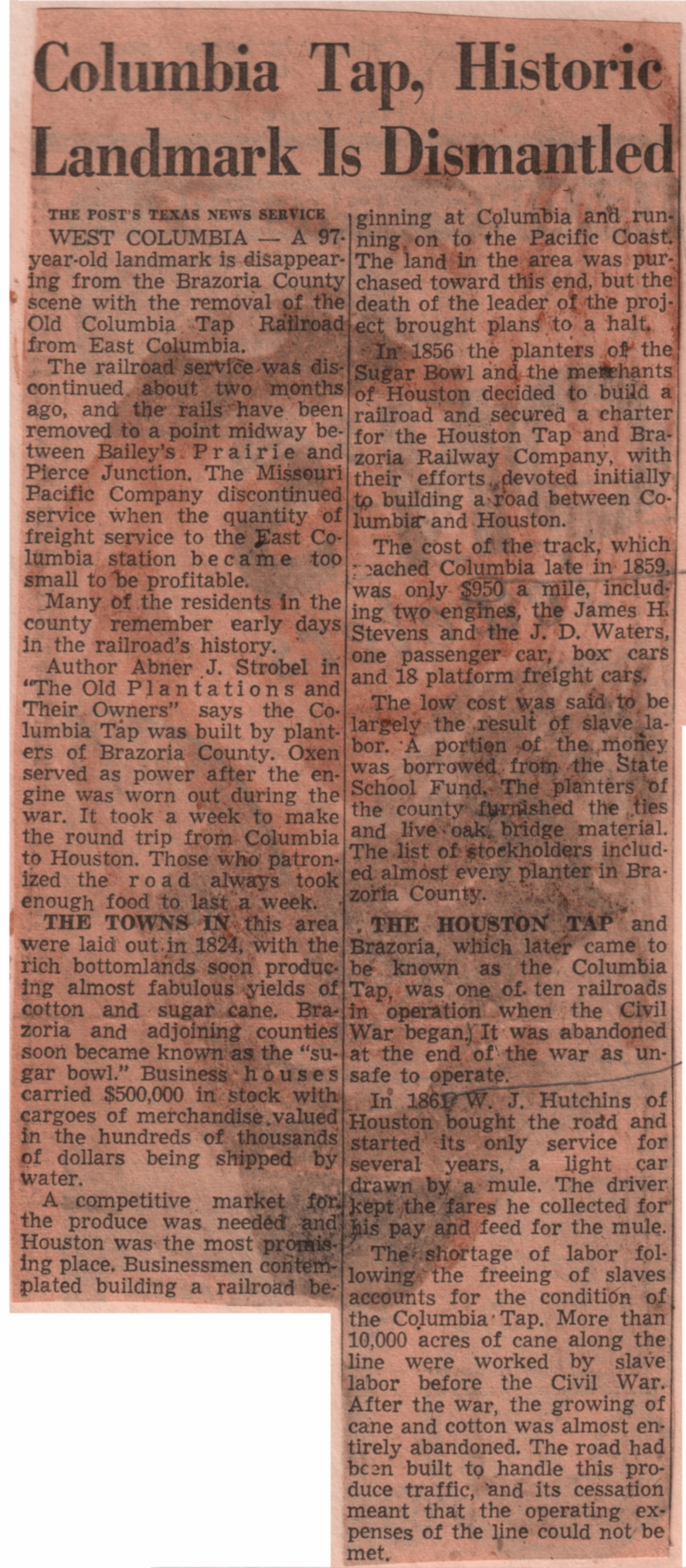
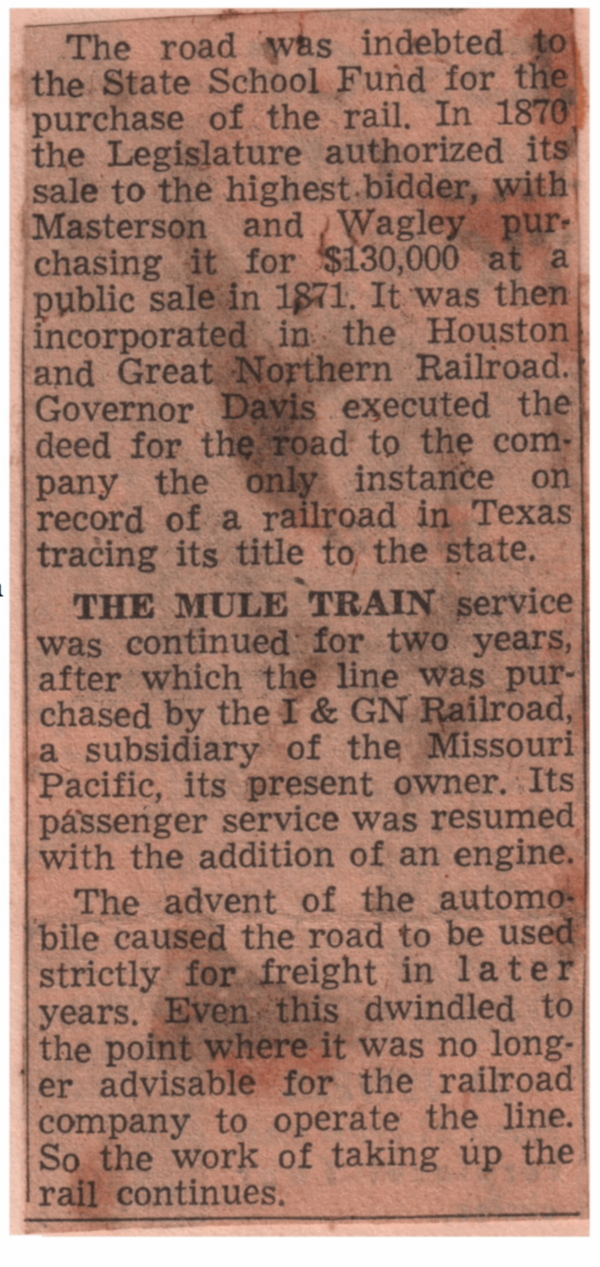
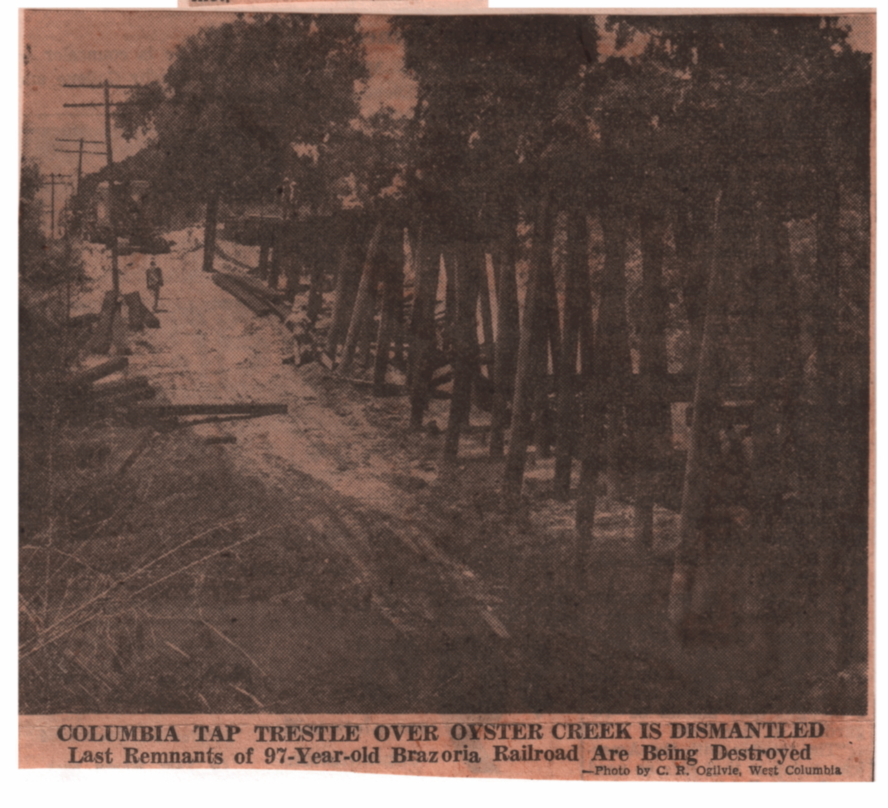
The Columbia Tap ended directly across from Bell's Landing, never crossing the Brazos River .